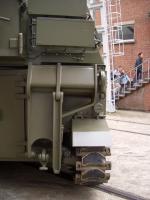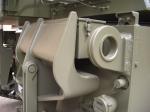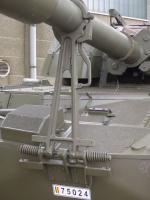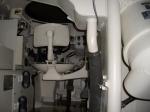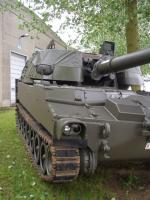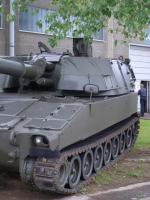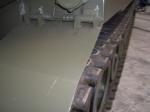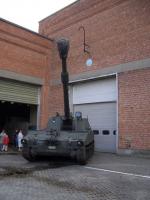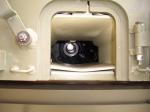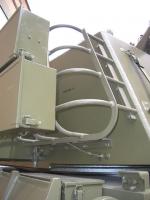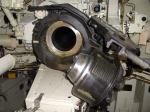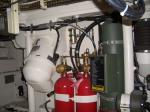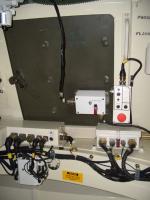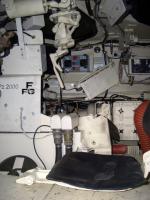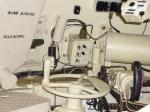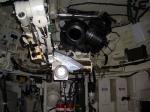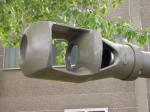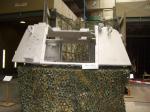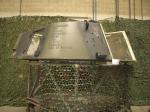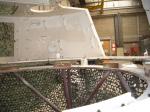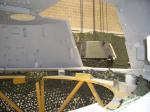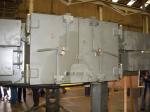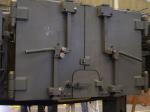
|
|||||||||||||||||||||||||||||||||||||||||||||||
 En effet la 1° première batterie d’Artillerie à Cheval belge se trouve à le 18 juin 1815 à Waterloo mais du coté Coalisés où elle prend sous ses feux la Garde Impériale de Napoléon. Apres 1815 une formation d’Artillerie à Cheval « belge » continue d’exister dans le Royaume de Hollande En 1830, lors de la proclamation del’ Indépendance le gouvernement provisoire forme dix compagnies d’artillerie qui participent à la campagne des dix jours (1831) En 1834 Les trois premières " Batteries à cheval " sont constituées . Il s’en suit une longue période de paix et ce n’est que durant la 1° Guerre Mondiale que les canons vont parler
Organisation du RACh
Le Régiment Rijdende Artillerie à Cheval (Regt RACh), caserné à Altenrath tout près de Cologne, était un régiment d'artillerie classique en appui d'une brigade mécanisée. Fort de 408 hommes en temps de paix devant atteindre 740 en temps de guerre il disposait d'un état-major, d'une batterie état-major et de trois batteries de tir (A, B et C). La troisième batterie était une batterie avec le matériel stocké.
Belgian M109 A2
As I have already introduced the M109A2 I will strive to make you a small portrait of Belgian regiment who have used this SPG
Origins
We must find the roots of these regiments and know little more e their history as we delve into the history and arrive at the XVIII° century and more specifically in the Horse Artillery regiments
We must find the origins of the Horse Artillery Regiment (all nations overcome )r in Prussia during the reign of Frederick the Great (1712 1786). It wanted to make more mobile his artillery also he decided to create in 1759, Horse artillery regiments by transformation of artillery units . The artillerymen were riding and implement it as quickly as they were nicknamed the “ Flying Gunners” because they were moving at a gallop with the battery and very fast.For Belgium the birth of the armed must be found in 1815
Birth of the Horse Artillery Belgian
 Indeed, the 1st Belgian Horse Battery Artillery lies on June 18, 1815 in Waterloo, but inside of the Allie where it takes under his fire the Imperial Guard of Napoleon. After 1815 a Horseg Mounted Artillery "belge" continues to exist in the Kingdom of the Netherlands and in 1830 in the proclamation del Independence the temporary government form 10 artillery companies involved in the campaign for ten days (1831 ) In 1834 The first three Horses Batteries are held. It follows a long period of peace and it is only during the World War 1 ° the guns will speak
The War 1914-1918
The Mounted Artillery (ACh) was formed in 1914 in to 2 groups each consisting of two and later three batteries assigned to various units
The period 1919 - 1940
The 1 ° ACh group is independent. It is part of the only Belgian Cavalry Division and is stationed in Leuven. The 2 ° ACh Group is barracks in Mechelen, is the first part of 6A. When creating the 2 ° Cavalry Division in September 1914) he went to it. After the dissolution of the Division, in early 1918, the 2nd Group of ACh joined 12A. The facts of arms for these two units are eloquent 1 ° Groupement Battle of the Silver Helmets Haelen to August 12, 1914 Seat and counter-attacks near Antwerp Battle of the Yser where he plays, among other things, an important role in defending Stuyvekenskerke during the recapture of a key field near Reigersvliet March 6, 1918 Maldegem during the final offensive (citation and the award of the Order of Leopold). 2 ° Groupement Seat and counter-attacks in Antwerp Combat bridgehead of Nieuport War trenches which earned him the citation "Yser" Offensive finale, in the success Passchendale and almost Rumbeke, The period of peace returns and the Horse Artillery participated in the occupation of the Rhineland until October 15th 1923, when an Horse Artillery Regiment is bringing together all groups to Horse Artillery. This Regiment first part of the "Light Division" and, from 1926, the Corps Cavalry. He settled in the barracks at St Martin Louvain.
The post-war period.
1936 saw the start of the motorisation and the change of name of the Regiment, which becomes Regiment Artillerie du Corps de Cavalerie (RACC) In 1939, 3 independants Regiments will be trained from RACC, the 17A, 18A and 19A who fight with bravery during the campaign of 1940
The Belgian forces reborn in 1945 and in 1950 reappear, units Horse Artillery
Organization of the RACh
Indeed during the reorganization of the Ground Force in 1950, three artillery units were created within the 16 ° BD and in1951 we found: The 17ACh (17RA) with the traditions of 1st group ACh (1914 - 18) and 17A (1940); The 17ACh is created and Aachen with the standard of Artillery Regiment of the Corps Cavalry. The 18ACh (18RA) who inherits the traditions of the 2nd Group ACh (1914 - 18) and 18A (1940); 18ACh was creared in Euskirchen and quarterd in barrack at Alterrath then he receives a banner with a quote from the Artillery 2 Cavalry Division. The 19ACh perpetuates the traditions of 19A (1940); 19ACh is created in Düren and receives a banner with the quote "Battle of Belgium 1940." The materials will be used successively howitzer M7 (105 mm SP), M44 (155 mm SP), M108 (105 mm SP), M109 (155 mm SP), and since 1985, M109 A2 (155 mm SP) . In 1986 the 17RA and 18RA belong to the Artillery Corps. They are two active batteries and a battery reserve. The 19ACh, which is the organic battalion of the 17 Armoured Brigade, has two active. All these batteries are eight howitzers. In 1994 after a restructuring, 17RA, 18RA and 19ACh merge into a single regiment, which becomes the new Artillery Regiment Mounted (RACh Regt). This Regiment inherits the traditions of all units at Horse Artillery. And he receives the corps Standart of the Regiment Cavalry of 1939. It is barracked at Altenrath and is composed of two active bartterie and a reserve battery . He make part of the 17th Mechanized Brigade with its headquarters in Spich. After the fall of the Berlin Wall on March 30th 2001, the Council of Ministers has decided to withdraw the 'Belgian Germany Forces' (BAF). Resulting in the December 31th 2001 end of the mission of the RACh Regiment, which is dissolved June 30th 2002 the Regiment RACh is dissolved. On December 6th 2002, the Artillery Battery Campaign Para Commando receive the standard and traditions of horse artillery. In OPEX he participated in operations Former Yugoslavia between 1992 and 1995
The Rijdende Artillery Regiment Mounted (RACh Regt), quartered in barrack at Altenrath near Cologne, was an traditional support artillery regiment of a mechanized brigade. With 408 men in peacetime to reach 740 in wartime he had a headquarters, a battery HQ and three firing batteries (A, B and C). The third battery was a battery with the material stored.
Each battery had M109A2 howitzers 8 In wartime, the regiment could bring 24 guns with a range of 18.5 kilometers fed to 225 shots per piece. Alongside these tracked howitzers, the regiment had yet 10 armoured command VBCL, 13 armoured infantry M113 and Leopard 2 tanks TRV stores for a total of 43 devices tracked. The train regiment could carry 320 tons of ammunition on its 70 Volvo heavy trucks In total the regiment had 185 wheeled vehicles (30 Iltis jeeps and 27 Unimog)
|
|
Droit d’auteur La plupart des photographies publiées sur ce site sont la propriété exclusive de © Claude Balmefrezol Elles peuvent être reproduites pour une utilisation personnelle, mais l’autorisation préalable de leur auteur est nécessaire pour être exploitées dans un autre cadre (site web publications etc) Les sources des autres documents et illustrations sont mentionnées quand elles sont connues. Si une de ces pièces est protégée et que sa présence dans ces pages pose problème, elle sera retirée sur simple demande. Principaux Collaborateurs:
Nb
de visiteurs:8680633 Nb
de visiteurs aujourd'hui:11706 Nb
de connectés:154
| |||||||||||||||||||||||||||||||||||||||||||||





